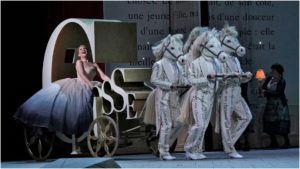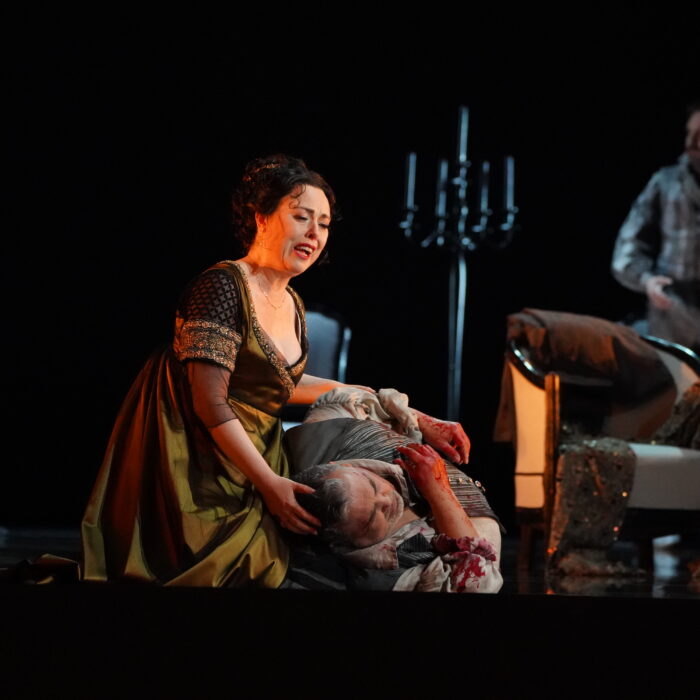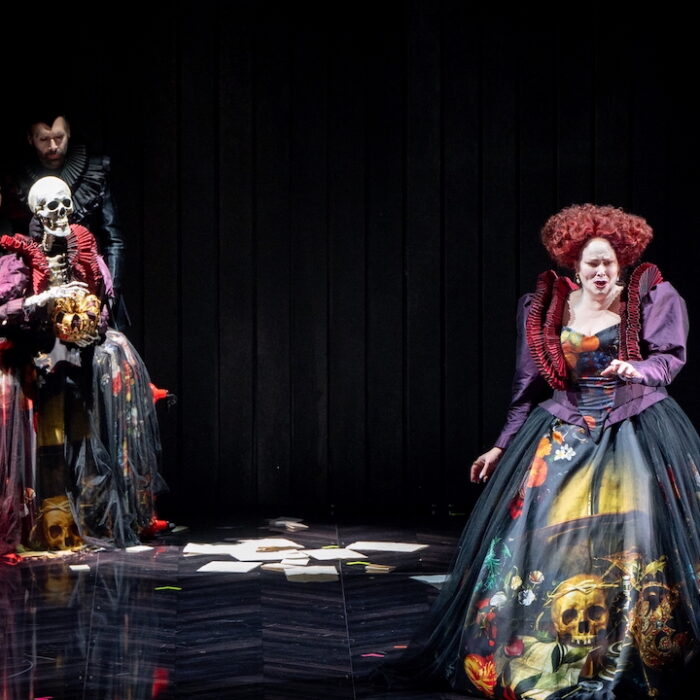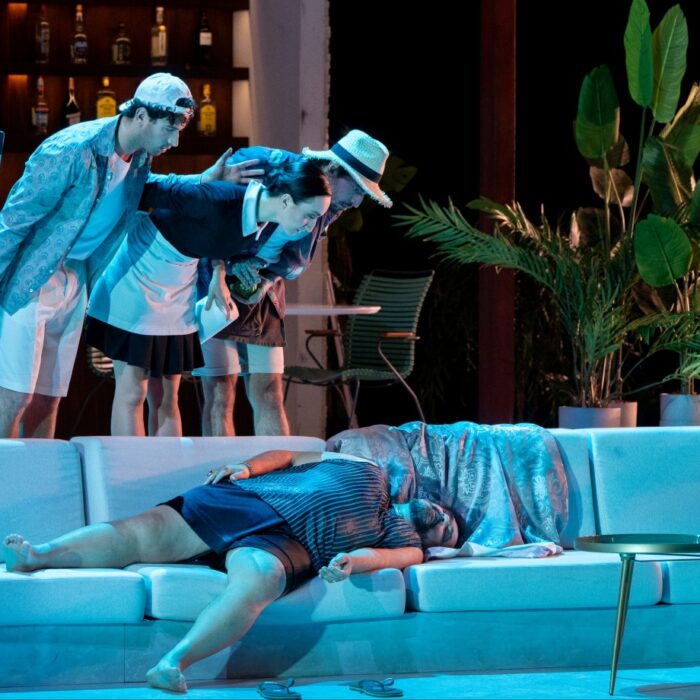
Metropolitan Opera 2017-18 Review – Cendrillon: Laurent Pelly, Joyce DiDonato & Company Deliver Exquisite Evening of Massenet Fairy Tale
By David SalazarJules Massenet is one of the great composers that can’t be called an auteur in the traditional sense. When you go to any performance of music by virtually any composer, you can pretty much guarantee that said composer’s voice will come through consistently even if the means or style deviates ever so slightly. Verdi remains Verdi whether you are listening to “Luisa Miller” or “Otello.” Wagner is clearly Wagner in both “Tannhäuser” and “Parsifal.”
Massenet remains Massenet in “Werther” or “Don Quichotte” or “Cendrillon” and yet he isn’t. The ultimately operatic chameleon, Massenet had a musical flexibility that no one seemed to possess in opera history, his style changing to suit the story. Where composers would make the story work for their style, Massenet did the opposite, making his music work in service of the music.
I’ve always had this incredible sense of discovery with the French composer’s work and it continued Friday night in seeing and hearing the enchanting “Cendrillon” at the Metropolitan Opera.
Coalescing Textures
The opera premiered in 1899 and belongs to his middle period, after such masterworks as “Werther,” “Thaïs,” and “Manon.” And while you will certainly here some harmonic qualities and lines that couldn’t be anyone else but Massenet’s the music itself feels far freer and rhapsodic than anything you might hear in his other works. Massenet blends the magical, the comical, and the romantic into one seamlessly even if his musical language takes on different forms in differing contexts. Pandolfe, Madame de la Haltière, and the two sisters Noémie and Dorothée belong to one sound world that is filled with farce and high comedy, the music light and playful. The Fairy Godmother’s music is freer and looser in its harmonic range. Cendrillon and her Prince play in yet another harmonic world, the music more delicate and yet passionate.
All of these textures were beautifully articulated by conductor Bertrand de Billy, who was like a painter throughout the evening, highlighting one color after another. De Billy did some heavy lifting over the weekend, conducting three operas by three titanic composers (for the record, I saw all of the performances) and “Cendrillon” was undeniably in his comfort zone. To say that the Met Opera played with polish and sheen would be an understatement; you’ve rarely heard the ensemble sound this good. Massenet’s music never builds to the passionate sweep we often get in “Manon” or “Werther” or the finale of “Thaïs” (admittedly, it doesn’t have to), and yet De Billy imbued the music with the same intensity and sense of emotional focus.
Convergence of Styles
Taking his cues from this free-flowing conducting, director Laurent Pelly crafted a showcase that is, beyond a shadow of a doubt, the best new production of the Met’s 2017-18 season. It was expressionistic in nature, with the high comedic moments played up by over-the-top choreography, but it all played into the childish imagination of watching a fairytale.
The story of “Cendrillon” is right up there on stage for us to see the moment the curtain rises, albeit in French. The servants of Madame de la Haltière flutter across the stage in high synchronization. The stage panels fold and unfold throughout the night like a storybook, taking us to different environments, which keeps the production in constant flow. When we get to the castle, the servants parade about in hilarious exaggerated dance. At the great ball, we see every dance about and join in a big circular line that looks like so much fun, even the King himself joins in. Pandolfe, Madame de la Haltière, and her daughters are all part of this hilarity, their styles in line with these exaggerations that fill this world with effervescence. Laughter rang out every single time these setpieces took the stage or confrontations between this quartet of characters came to the fore.
The Fairy Godmother’s visual world featured fantasy. The spirits all took on different forms throughout – in their first appearance, they looked like carbon copies of Cendrillon herself, emphasizing her loneliness, but also the fact that she had support and care around her.
The colors blue and red became competing motifs throughout – the comedic characters in Cendrillon’s household and the Prince’s court lived in the red color gradient with correspondingly tinted clothing, while the Fairy Godmother’s visual palette emphasized blue throughout. These color choices reflected the bright and fun pomp of the court and the mysterious magic of the Fairy Godmother.
In the midst of all this, Pelly shifted the style for the two lead characters, placing them in more naturalistic clothing and acting styles. Visually, Cendrillon’s affiliation is clearly with the blue of the Fairy Godmother and the Prince’s red suit places him in the court, but we never see them take on the highly stylized acting or vocal styles of the other characters. If anything, they are far more subdued in their behavior and singing, grounding the opera in their story of love.
It all comes together beautifully in the final moments of the opera when Massenet and librettist Henri Cain made a final move to have the characters break the fourth wall and talk to the audience. Pelly’s mise-en-scene here is fantastic, especially as he has the Fairy Godmother mirror the conductor’s final musical punctuations – all the worlds of comedy, romance, fantasy, and our reality suddenly, for one moment merge into one. That’s magical.
Two Isolated Lovers
Superstar Joyce DiDonato was the motor behind this Met Opera premiere run, having championed the role in a way few others have. DiDonato’s voice is one of peculiar wonder. Her high notes tend to feel somewhat disembodied with a laser-quick vibrato that is unique to any other sound you’ve ever heard. The color of this sound doesn’t necessarily suit the gentle colors she utilizes in characterizing Cendrillon throughout, but it certainly doesn’t detract from a subdued interpretation. From her opening entrance, where Cendrillon doesn’t appear through a doorway, but through a hatch near the floor, her manner was one of melancholy, her vocal line floating elegantly throughout. Whereas the preceding events showcase characters working to interact with the audience, DiDonato’s performance here was more about doing the reverse, bringing the audience into a more introspective realm. You could feel tension as her voice seemed intent on rising up and imploded with arduous sound, and yet it never came. Even in her scene where she prepares to die in the forest, DiDonato retained this internalized reading of the characters; it was a perfect counterpoint to the explosiveness of the world around her.
We got a greater sense of this passion in the duets with the Prince, both at the end of the second act and end of the opera, both voices sounding fresh and soaring in these enchanting moments. It seemed like a release for both characters from these more reserved interpretations. Alice Coote’s voice had a glorious gleam throughout the evening and did a fantastic job of exploring the Prince’s sense of isolation in the big crowd scenes with her body language. She was constantly slouched over, her eyes darting to the floor. But when Cendrillon came to the Prince’s world, Coote’s posture changed completely, the Prince suddenly looking potent and excited.
Chewing Up the Scenery
The supporting characters were undeniably scene-stealers in all of this.
Kathleen Kim’s voice sounded as fresh as ever in the role of the Fairy Godmother. She had a snappy and witty personality and tossed off high notes with ease. There was seductive quality to her singing as she did her best to bring the lovers together in the forest scene, and while she retained this sense of lightness, she also looked commanding on stage.
Speaking of command, no one chewed up the scenery quite the way Stephanie Blythe did as Madame de la Haltière. To say she was imposing would be an understatement; the moment she came onstage, all eyes were on her. Constantly toying with Laurent Naouri’s Pandolfe (in one hilarious exchange she repeatedly shut him up when he protests), she moved about methodically, her voice packing a punch every single time she opened it. She’s not a character to necessarily be taken seriously, but boy is she intimidating.
As Pandolfe, Naouri managed to imbue the character with depth. He sang boisterously in his confrontations with Blythe only to find himself in a more delicate and broken vocal quality in his isolated and lonely scenes. In his moments with DiDonato, there was tenderness and sweetness in the sound; overall, one might say that the French bass had the most nuanced of all the vocal performances of the night, giving the character a sense of added importance to the overall dramatic proceedings.
The mezzo and soprano duo of Maya Lahyani and Ying Fang were pitch-perfect (literally) as the sisters Noémie and Dorothée, the two matching their voices as if they melded into one. Physically they were indistinguishable, adding hilarity to their interactions with Blythe.
It was a magical evening through and through and the general laughter suggested that Pelly and the exquisite cast succeeded in immersing the audience fully into the story. Another unique observation I made from the evening was the high volume of young children at the performance, fully engaged in the production. Maybe “Cendrillon” shouldn’t be a one-off deal and has the potential to give younger audiences an experience previously reserved for a handful of operas. Should be interesting to see as the production continues to grow in coming performances.


